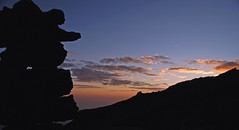Brighton pier - helter skelter view
Starting somewhat extremely with an ISO of 3200, I wanted to see the results of using the fastest film in my camera, and I have to admit to being pretty pleased with the result. While there is no doubt that it is pretty grainy the lights of the helter skelter in the distance are reasonably sharp and the people in the foreground have also been captured reasonably clearly. I could see using this high level of film to create a specific effect, particularly perhaps a rainy black and white type image, although it would be no use where pinsharpness is essential.
The image created using an ISO of 400 is less clear due to camera shake and the longer exposure time - but is also less grainy.
 ISO 3200 1/60 sec f5.6
ISO 3200 1/60 sec f5.6Funfair - movement
Composition aside I have struggled to distinguish significantly between these two images taken with ISO 200 and 800 respectively: they are both well lit, the colour is strong in both and the sense of movement has also been captured. The smaller aperture and shorter exposure time in the ISO 800 version however does provide greater scope for increasing depth of field and ensuring no issues with camera shake.
 ISO 800 1/25 sec f5.6
ISO 800 1/25 sec f5.6Christmas tree and moon
I have included all three images taken of this subject as the differences between ISO levels can easily be seen. The most successful image is, I think, that taken with ISO 800: a clear moon and individual lights (even when zoomed in) and limited graininess. The ISO 100 version shows clear signs of camera shake, unsurprisingly at 0.3 sec - although of course a tripod could have alleviated that. The ISO 400 version is somewhere in between - while not bad, the lights don't have the clarity of the ISO 800 version.
 ISO 800 1/20 sec f5.6
ISO 800 1/20 sec f5.6Wooden detail
I took a series of six images at this location - outside, but in shade. Three were at an ISO of 400, and the others at 100. Without exception, all ISO 100 images suffered from camera shake, whereas the ISO 400 images are clear and without real sign of graininess. Shooting in fine resolution I suspect helps this - even when zooming in on the images they tend to be much larger than I am ever going to use them, which minimises the speckled effect.
Into the sunset
Although the sun has disappeared other lights are emerging. These two images are taken at ISO 400 and 800 respectively, and I think the key difference between them is brought about by the extended shutter speed in the ISO 400 version, which has enabled more light to be cast on the railing.
Spiral
While I took this image indoors it was entirely illuminated by the natural light of massive windows and benefiting from an open view of the sea. I was aiming to maximise graininess to soften the smooth glass and metal edges of the central sculpure and spiral staircase, and so used an ISO of 1600. I like the effect overall - the subject too is clear to see even at this high level of sensitivity.
ISO 1600 1/125 sec f3.5






























_cropped.jpg)























